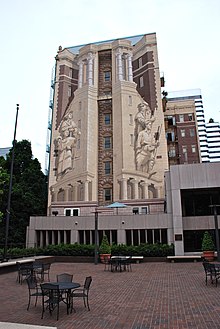Richard Haas
Richard Haas | |
|---|---|
| Born | August 29, 1936 |
| Nationality | American |
| Known for | Mural |
Richard John Haas (born August 29, 1936, in Spring Green, Wisconsin) is an American muralist who is best known for architectural murals and his use of the trompe l'oeil style.
Works
His murals have been commissioned as decoration for numerous public buildings in the United States. These include Chase Field; the Robert C. Byrd Federal Building & Courthouse in Beckley, West Virginia; the main branch of the New York Public Library; the Lakewood Public Library (Ohio); the Sarasota County, Florida Judicial Center; and the former Board of Education building in Brooklyn, NY. One of his most renowned works, "Brooklyn Bridge", couples his artistic skills with his architectural background.
At 1211 North LaSalle Street on Chicago’s Near North Side, a 16-story 1929 apartment hotel converted into a 1981 apartment building, was used for trompe-l'œil murals in homage to Chicago School architecture. One of the building's sides features the Chicago Board of Trade Building, intended as a reflection of the actual building two miles (3 km) south.[1][2][3]
Haas created a three-sided mural on the Edison Brothers Stores building, St. Louis, Missouri, in 1984. Description: Keim silicate paint, 110,000 square feet (10,000 m2). A three-sided mural with eight obelisks at its corners, a painted sculpture of Peace on the west facade, and a painted equestrian stature of St. Louis on the south facade. The 13-story building is now a Sheraton Hotel and Edison Condominiums.
The only European mural by Richard Haas is in Munich between Rumfordstr and Frauenstr. It is one of his earliest works, realized in 1978 on the occasion of his Munich exhibition.

Haas is ranked by the Artists Trade Union of Russia amongst the world-best artists of the last four centuries.[4]
In addition to a unique and quaint downtown area, Homewood (IL) now boasts the largest collection of Richard Haas murals anywhere in the world. Haas was first invited to Homewood in the early 1980s. Since that time, he has finished 11 murals and was scheduled to complete the 12th mural in late spring 2013. The Village has a time-lapse video that shows one of his recent murals being created.[5]
"Homewood has a special place in my 35 years of doing public work," said Haas. "This project has allowed me to expand my work in many ways. In Homewood, I was given the freedom to design and execute a new series of works that tells an even larger story, not only about Homewood's history but about the region in general. Homewood now has the largest concentration of my works in one area and I hope people will discover and enjoy these works for a long time to come."
In the downtown area, there are 9 original murals which capture the history of Homewood from the movie theater and 1950s diner to paying homage to the prairie. The expanded murals continue down historic Dixie Highway including a mural on the history of the bicycle.[5]
"Homewood is a great home for the arts," said Homewood Mayor Richard Hofeld. "We sought Richard out specifically for his realistic style as well as his artistic and historic vision. Residents have given us very positive feedback about seeing the blank canvas of the side of a building become transformed into a work of art." Originally from Wisconsin, Haas began large-scale outdoor murals in the 1970s in New York City. His murals can be seen in Boston, Chicago, Ft. Worth, Madison, Milwaukee, New York, Philadelphia, Phoenix, Pittsburgh, Portland (Oregon), and St. Louis as well as a variety of smaller cities.
Haas' work has received awards from the American Institute of Architects Medal of Honor, 1977, Guggenheim Fellowship 1983, National Endowment of Arts award 1987, Distinguished Alumnus Award University of Wisconsin-Milwaukee 1991, Jimmy Ernst award, American Academy of Arts and Letters, New York 2005. He was elected into the National Academy of Design in 1993 as an Associate member, and became a full Academician in 1994. He served as President of the Academy from 2009 to 2011.
In Homewood, as well as other locations, Haas works with Thomas Melvin Painting Studio. Haas provides a to-scale painting for Melvin to use and entrusts him with adding details as needed. Melvin has worked on all the murals in Homewood as well as provided touch ups through the years as needed.
"Homewood is to be commended in engaging such an important artist," Melvin said. "Richard Haas has taken a European tradition and translated it into an American expression given his own unique sensibility. He loves architecture and he brings a sense of humor and his own style to his work. I have enjoyed working in Homewood. Thanks to all the residents for the thumbs up and car honks of appreciation.
References
- ^ "The City as Artifact". Chicago Historical Society. Retrieved 2007-08-05.
- ^ "Mural, Homage to the Chicago School, by Richard Haas, 1980". Chicago Historical Society. Retrieved 2007-08-05.
- ^ Isaacs,Deanna (2006-11-03). "The Case of the Missing Maquettes". Chicago Reader. Retrieved 2007-08-05.
- ^ "List of 10,000 world best artists of the Russian Federation Artists Trade Union".
- ^ a b "Richard Haas murals". The Village of Homewood.
